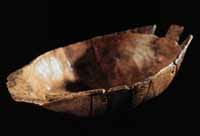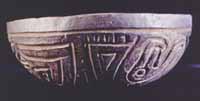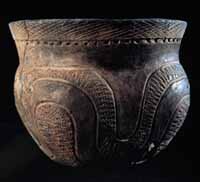
 |
Turtle shell bowl, Neteler site, Mason County. | |
|
A turtle shell requires relatively little modification to make a bowl. |
||
Native Americans used containers made of wood, fiber, and hide for thousands of years. They also used natural containers like gourds and turtle shells.
Pottery containers were developed sometime during the Late Archaic or Early Woodland period. Clay and crushed rock or sand were mixed together into a stiff dough that was made to form bowls and jars. Once dry, these containers were placed in a wood-fueled fire and baked hard. These fired-clay pots could hold liquid and they could be placed directly into the campfire to cook food more efficiently. Pottery was a revolutionary invention. Nearly every household in the world today has pottery containers.
 |
Pottery bowl, Elizabeth site, Pike County. | |
|
This highly decorated pottery bowl is about 2,000 years old. While the clay was still plastic, an artisan drew a design on the exterior of the bowl. Notice the head of a hooked-bill bird on the right side of the bowl. In the center of the bowl, you can see part of the wing of the bird and part of the tail is visible on the left side of the bowl. |
||
Early Woodland pottery is thick and crudely made. The vessels resemble flower pots. A few hundred years later, Middle Woodland people made much improved pottery, including highly decorated bowls and jars. Late Woodland pottery is simpler in design, but stronger and lighter.
 |
Pottery jar, C. W. Cooper site, Fulton County. | |
|
The exteriors of Middle Woodland pots were often highly decorated with lines and geometric designs. Archaeologists continue to try and interpret the meaning of the designs. Some have suggested that they represent designs of particular families or group members. |
||
|
|
Copyright © 2000 Illinois State Museum